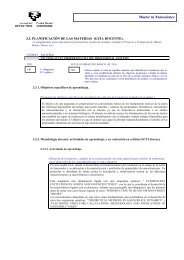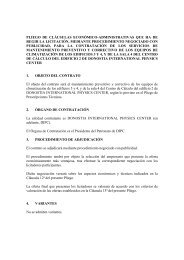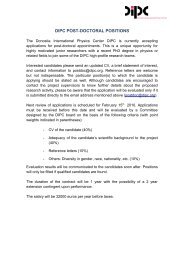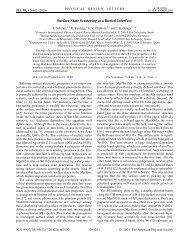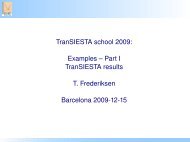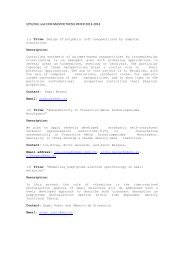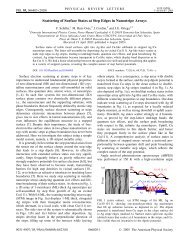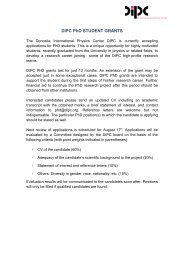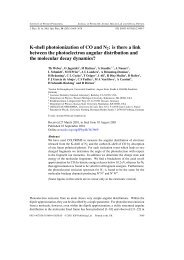Complete report - Donostia International Physics Center - Euskal ...
Complete report - Donostia International Physics Center - Euskal ...
Complete report - Donostia International Physics Center - Euskal ...
Create successful ePaper yourself
Turn your PDF publications into a flip-book with our unique Google optimized e-Paper software.
2011 DIPC Highlight<br />
Time-dependent electron<br />
phenomena at surfaces<br />
R. Díez Muiño, D. Sánchez-Portal, V.M. Silkin, E.V. Chulkov, and P.M. Echenique<br />
Proceedings of the National Academy of Science PNAS 108, 971 (2011)<br />
The research work summarized in the article provides new insight into the physical phenomena that<br />
appear in very small systems, in the nanometer scale, and very short times, in the attosecond scale.<br />
In the last decade and due to the development of sophisticated experimental techniques, mostly based<br />
on laser sources, electron dynamics in nanometer-scale regions has become accessible and reasonably<br />
well understood. However, these techniques were unable to obtain time resolutions below the femtosecond<br />
scale until very recently. In practice, this limitation meant that electron dynamics could not be studied<br />
in the time scale in which chemical reactions actually happen. Ultrashort laser pulses have dramatically<br />
change the situation and attosecond physics is currently becoming a reality. Nowadays, it is indeed possible<br />
to reach the time scale in which a chemical reaction is produced or an electron is photoemitted<br />
from a surface or a nanostructure. The understanding and control of charge transfer times and electronic<br />
excitation survival times is a necessary step to understand, control, and design physical and chemical<br />
processes at surfaces. This is the focus of the scientific article published by DIPC researchers in PNAS.<br />
In the research work summarized in the article, the authors use state-of-the-art theoretical methods to<br />
analyze very refined features of femtosecond and attosecond electron dynamics. In particular, it is shown<br />
that the screening of localized charges at metal surfaces is created locally in the attosecond time scale,<br />
while collective excitations transfer the perturbation to larger distances in longer time scales. The time<br />
necessary for an electron to jump from an adsorbed atom to a magnetic surface is also analyzed. It is predicted<br />
that the elastic width of the resonance in excited alkali adsorbates on ferromagnetic surfaces can<br />
depend on spin orientation in a counterintuitive way. Active manipulation and control of magnetic ordering<br />
down to a single atomic magnet, such as a single atomic spin on a surface, is of great importance for potential<br />
applications in spintronics. Finally, the electron–electron and electron–phonon contributions to the<br />
electronic excited states widths in ultrathin metal layers are quantitatively evaluated. The time that an electron<br />
spends traveling inside an ultrathin Pb film without suffering a collision with other electrons is found<br />
to depend on the film thickness. Increasing the thickness of an ultrathin Pb film by just one atomic layer<br />
can reduce the travelling time of electrons before collision. However, increasing the thickness of the film<br />
by two atomic layers can considerably increase this travelling time.<br />
Time evolution of the change in electronic density induced by an external point charge at a Cu surface.<br />
Confinement and spin effects are<br />
key factors in the behavior of electron<br />
dynamics at metal surfaces.<br />
In summary, the study provides new insight into the physical phenomena that appear in very small systems,<br />
in the nanometer scale, and very short times, in the attosecond scale. It shows that some of the properties<br />
found in ultrafast processes at the nanoscale are far from intuitive. An additional conclusion that can be<br />
extracted from this research work is that confinement and spin effects are key factors in the behavior of<br />
electron dynamics at metal surfaces.<br />
78 DIPC 10/11<br />
DIPC 10/11 79



